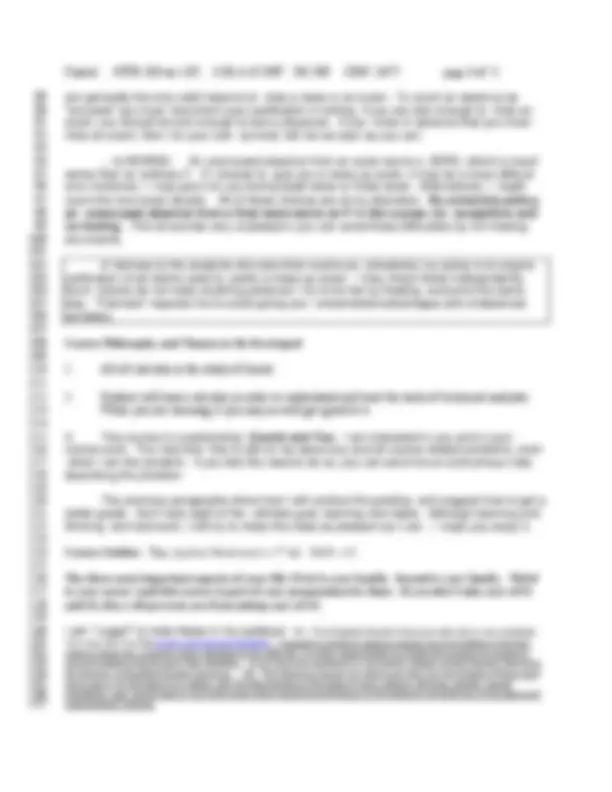



Study with the several resources on Docsity

Earn points by helping other students or get them with a premium plan


Prepare for your exams
Study with the several resources on Docsity

Earn points to download
Earn points by helping other students or get them with a premium plan
Community
Ask the community for help and clear up your study doubts
Discover the best universities in your country according to Docsity users
Free resources
Download our free guides on studying techniques, anxiety management strategies, and thesis advice from Docsity tutors
The syllabus for a calculus for business course (mth 203 sec 105) at marshall university. It includes course description, required text, office hours, attendance and grading policies, and desired learner outcomes. Prerequisites and evaluation methods are also outlined.
Typology: Exams
1 / 3

This page cannot be seen from the preview
Don't miss anything!


MTH 203 Syllabus Course: Calculus for Business MTH 203 sec 105 3:30-4:45 MW SH 509 CRN: 3477 Required Text: Tan, Applied Mathematics, 3rd^ ed. Ch 9 – 12 Recommended Materials: A scientific calculator, which will show some of these: log, exp, ln, ex, sin, cos, tan. (We don’t use sin, cos, & tan). Keep the instruction manuals for it. (Some graphing calculators will evaluate integrals and derivatives, but they are expensive and are NOT required and will NOT be allowed on exams.) A scientific calculator will be allowed on exams. 8 David A. Cusick, Ph.D. SH766 696-3038 cusick@marshall.edu avoid email! 9 Office Hours: 10 – 11 M Tu W Th F 1–2 M Tu W Th 3-3:30 M W and by appointment. 10 Drop-in visits are possible but “iffy.” 11 These office hours are subject to change since the University will usually give me a pile of 12 nonclassroom duties and meetings as time passes.
13 14 15 16 17 18
Course Description, Credits Prerequisites : (quoted from the MU catalog) Fundamental aspects of calculus are covered with applications in business and economics. The topics covered include limits differentiation, integration and some multivariable calculus. Prerequisites: MTH 123 or equivalent, or ACT at least 25 on the math portion Prerequisites in the class schedule: You must exceed one exam score or pass one of these courses.
ACT 25 SAT 580 MTH 120 MTH 123 MTH 127 MTH 130E MTH 130 MTH 132
19 20 21 22 23 24
Desired Learner Outcomes/Objectives: Student will learn ... that calculus is the study of limits. ...to calculate derivatives and interpret them as rates of change. ...to calculate integrals and to interpret them as accumulations and limits of sums. ...to optimize functions using derivatives. ...to relate a function’s graph behavior to the function’s first and second derivatives. ...to learn partial derivatives and some multivariable differential calculus. ...to apply derivatives to word problems
25 Student will learn calculus in order to understand and trust the tools of technical analysts 26 with whom the student will be working.
27 28 29 30 31 32
Evaluation/Measurement of Learner Outcomes: Attendance & Quizzes/Evaluations ....................... 10%, 50 points ♣Class Discussion ................................................... 5%, 25 points (nominal) ♣Blackboard Work.................................................... 5%, 25 points (nominal) Hour Exams..(3)...................................................... 60%, 300 points 33 #Comprehensive Final Exam................................... 20%, 100 points 34 35 36 37 38 39 40 41 42 43 44
Total.........................................................................100%, 500 points
♣Discussion and blackboard are two pools of points which will transfer from student to student. Each of these is a zero-sum game. Points that are earned by one student are therefore lost by the other students, and vice-versa. The sum of gained (positive) and lost (negative) is zero. This corresponds to a situation of pure competition. You can earn extra credit by getting points from other students, or you can lose points to others. Students who drop (officially or otherwise) will be dropped from these zero-sum games, and this can affect the point totals of students who remain. . #The final exam may be partly, or entirely, multiple choice
Assessment Evaluation Methods:
Grading Policy: My usual scale is 90%, 80%, 70%, 60%. (So, 90% earns an A, 80% earns at least a B, etc. We can discuss your grade at any reasonable time.) At my discretion these percentages may be lowered (made easier to attain), but they will not be raised. On a multiple-choice exam they are very likely to be lowered (made easier for you). Due Dates for Examinations: Exam 1: Wed., 9/20/06 Exam 2: Wed, 10/18/06 Exam 3: Wed, 11/15/06 *
Comprehensive Final Exam: Mon, Dec.11, 2006* 3:30PM — 5:30PM in our classroom
*** Be careful when buying nonrefundable airline tickets!** Check your final exam schedule.
70 Labor Day Holiday 9/4/06 Freshman Mid-Term Grades Due Mon, 10/16/ 71 72 73 74 75 76 77
Last day to drop one full-semester course Fri., 10/27/06 Thanksgiving Holidays 11/19 – 11/26/ Dead Week 11/29/06 — 12/5/06 First--Last class day: 8/21--12/5/ Attendance Policy: Success will require several daily activities: 1. Read the books. 2. Do two or three hours of homework each class day. If you cannot finish an assignment for reasons of time, then skip every second problem. If you cannot do an assignment because the problems are too difficult, then see me ASAP. 3. Attend class, ask questions and volunteer for discussion and board work. 4. Use office hours to supplement (not replace) classroom hours.
Daily class attendance and business-like manners are part of your responsibility. The class is your best source of information for the exams, and your attendance and participation count directly in your course grade. To be counted present for a given day you must sign the class attendance sheet during that class period. Even if you are absent, you are responsible for any and all material covered or assigned.
From BAD....: Illness, genuine personal emergencies, and university-excused activities